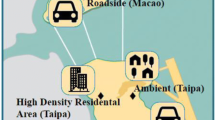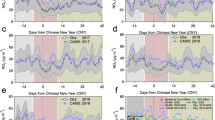Abstract
The adverse health effects associated with exposure to CO range from the more subtle cardiovascular effects at low concentrations to death after acute or chronic exposure to higher concentrations. The forecasting of the daily CO maximum levels is therefore essential in every attempt for protecting and improving public health in urban areas. The objective of this work is to create a suite of statistical models for predicting the one-day-ahead maximum CO levels based on both the meteorological and the pollutant data recorded in six monitoring sites in the greater area of Athens, Greece. The meteorological variables used as input consist of hourly values of the surface air Temperature, the Relative Humidity, the Wind Speed and the Wind Direction, while the pollutant parameters consist of hourly concentrations of nitrogen oxide, nitric dioxide, ozone and sulfur dioxide, all corresponding to the 7-year-period between 2001 and 2007. The models were developed on a seasonal (warm vs. cold period) and hebdomadal (workdays vs. weekends) basis and revealed that the influence of the air pollution levels recorded one day before (day m−1) on the maximum CO concentrations of day m is quite variable and depends on the site/type of the station, the local meteorology and the emission sources. Additionally, the analysis revealed that the CO concentrations are influenced by both local and/or wider area CO sources, suggesting a strong persistence of the CO levels, while only local meteorology (e.g. in the vicinity of the station and especially during working days) plays a role in the formation of present day’s CO levels. The derived models were validated against an independent yearlong data set (2008) through the use of a classical set of validation parameters known as the Model Validation Kit. Indices assessing the ability of the models to predict the CO exceedances of the EC limit value were also used. On the whole, it was found that the prognostic models introduced here manage to predict the CO maximum daily values in a satisfactory level, with Pearson’s correlation coefficients ranging between 0.62 and 0.76 during the warm period and between 0.51 and 0.80 during the cold period of the year. Similarly the index of agreement ranges between 0.50–0.95 during the warm period and 0.57–0.81 during the cold period of the year, revealing a rather adequate model performance.


Similar content being viewed by others
References
Alm S, Jantunen MJ, Vartiainen M (1999) Urban commuter exposure to particle matter and carbon monoxide inside an automobile. J Exposure Sci Environ Epidemiol 9:237–244
Barcenas O, Olivas E, Guerrero JD, Valls G, Rodriguez C, Tascon S (2005) Unbiased sensitivity analysis and pruning techniques in neural networks for surface ozone modeling. Ecol Modell 182:149–158
Basurko E, Berastegi G, Madariaga I (2006) Regression and multilayer perceptron-based models to forecast hourly O3 and NO2 levels in the Bilbao area. Environ Modell Softw 21:430–446
Burrows WR, Benjamin M, Beauchamp S, Lord ER, McCollor D, Thomson B (1995) CART decision-tree statistical analysis and prediction of summer season maximum surface ozone for the Vancouver, Montreal, and Atlantic regions of Canada. J Appl Meteorol 34(8):1848–1862
Chaloulakou A, Kassomenos P, Spyrellis N, Demokritou P, Koutrakis P (2003) Measurements of PM10 and PM2.5 particle concentrations in Athens. Greece Atmospheric Environ 37:649–660
Chelani A, Devotta S (2007) Prediction of ambient carbon monoxide concentration using nonlinear time series analysis technique. Transp Res Part D 12:596–600
Chien LC, Bangdiwala SI (2012) The implementation of Bayesian structural additive regression models in multi-city time series air pollution and human health studies. Stoch Environ Res Risk A. doi:10.1007/s0047701205624
Comrie A, Diem J (1999) Climatology and forecast modeling of ambient carbon monoxide in Phoenix. Arizona Atmospheric Environ 33:5023–5036
EC (2008) Directive 2008/50/EC of the European Parliament and of the Council of 21 May 2008 on ambient air quality and cleaner air for Europe. Official Journal of the European Union No. L152, Brussels, p 44
Grivas G, Chaloulakou A (2006) Artificial neural network models for prediction of PM10 hourly concentrations in the greater area of Athens. Greece Atmospheric Environ 40:1216–1229
Holloway T, Spak SN, Barker D, Bretl M, Moberg C, Hayhoe K, Van Dorn J, Wuebbles D (2008) Change in ozone air pollution over Chicago associated with global climate change. J Geophys Res. doi:10.1029/2007JD009775
Karatzas K, Papadourakis G, Kyriakidis I (2009) Understanding and forecasting air pollution with the aid of artificial intelligence methods in Athens, Greece. In: Koutsojannis C, Sirmakessis S (eds) Tools and applications with artificial intelligence, studies in computational intelligence, vol 166. Springer, Berlin, pp 37–50
Kassomenos P (2005) Socioeconomic aspects in an extended contemporary city. Water Air Soil Pollut 162:315–329
Katsoulis BD, Kassomenos PA (2004) Assessment of the air quality over urban areas by means of biometeorological indices. The case of Athens. Greece Environ Technol 25:1293–1304
Kukkonen J, Partanen L, Karpinen A, Ruuskanen J, Junninen H, Kolehmainen M, Niska H, Dorling ST, Chatterton T, Foxall R, Cawley G (2003) Extensive evaluation of neural network models for the prediction of NO2 and PM10 concentrations, compared with a deterministic modeling system and measurements in central Helsinki. Atmospheric Environ 37:4539–4550
Kumar U, Jain VK (2010) ARIMA forecasting of ambient air pollutants (O3, NO, NO2 and CO). Stoch Environ Res Risk A 24:751–760
Lalas D, Veirs VR, Karras G, Kallos G (1982) An analysis of the SO2 concentration in Athens. Greece Atmospheric Environ 16(3):531–544
Lioy PJ (1990) Assessing total human exposure to contaminants: a multidisciplinary approach. Environ Sci Technol 24:938–945
Martin ML, Turias IJ, Gonzalez FJ, Galindo PL, Trujillo FJ, Puntonet CG, Gorriz JM (2007) Prediction of CO maximum ground level concentrations in the Bay of Algeciras, Spain using artificial neural networks. Chemosphere 70:1190–1195
Martins DK, Stauffer RM, Thompson AM, Knepp TN, Pippin M (2012) Surface ozone at a coastal suburban site in 2009 and 2010: relationships to chemical and meteorological processes. J Geophys Res. doi:10.1029/2011JD016828
Mott JA, Wolfe MI, Alverson CJ, Macdonald SC, Bailey CR, Ball LB, Moorman JE, Somers JH, Mannino DM, Redd SC (2002) National vehicle emissions policies and practices and declining US Carbon Monoxide-related mortality. J Am Med Assoc 288(8):955–988
Murena F, Ricciardi G (2004) CO residence times on urban roads in the Naples area using air quality monitoring data. Atmos Environ 39:1993–2001
Olesen HR (1995) The model validation exercise at Mol: overview of results, workshop on operational short-range atmospheric dispersion models for environmental impact assessment in Europe. Int J Environ Pollut 5:761–784
Ordieres JB, Vergara E, Capuz R, Salazar R (2005) Neural network prediction model for fine particulate matter (PM2.5) on the US–Mexico border in El Paso (Texas) and Ciudad Juarez (Chihuahua). Environ Modell Softw 20:547–559
Paschalidou AK (2009) Adaptation of the BOXURB model in a southeastern European Environment. The case of Athens. Environ Monit Assess 158(1–4):265–278
Paschalidou AK, Kassomenos PA (2004) Comparison of air pollutant concentrations between weekdays and weekends in Athens, Greece for various meteorological conditions. Environ Technol 25:1241–1255
Paschalidou AK, Kassomenos P, Bartzokas A (2009) A comparative study on various statistical techniques predicting ozone concentrations: implications to environmental management. Environ Monit Assess 148:277–289
Paschalidou AK, Karakitsios S, Kleanthous S, Kassomenos PA (2011) Forecasting hourly PM10 concentrations in Cyprus through artificial neural networks and multiple regression models: implications to local environmental management. Environ Sci Pollut Res 18:316–327
Perez P, Palacios R, Castillo A (2004) Carbon monoxide concentration forecasting in Santiago. Chile J Air Waste Manage Assoc 54:908–913
Raub JA, Mathieu-Nolf M, Hampson NB, Thom SR (2000) Carbon monoxide poisoning—a public health perspective. Toxicology 145(1):1–14
Saide P, Carmichael GR, Spak SN, Gallardo L, Osses AE, Mena-Carrasco MA, Pagowski M (2011) Forecasting urban PM10 and PM2.5 pollution episodes in very stable nocturnal conditions and complex terrain using WRF-Chem CO tracer model. Atmospheric Environ 45:2769–2780
Schlink U, Dorling St, Pelikan E, Nunnari G, Cawley G, Junninen H, Greig A, Foxall R, Eben K, Chatterton T, Vondracek J, Richter M, Dostal M, Bertucco, Kolehmainen M, Doyle M (2003) A rigorous inter- comparison of ground level ozone predictions. Atmos Environ 37:3237–3253
Schlink U, Herbarth O, Richter M, Dorling ST, Nunnari G, Cawley G, Pelikan E (2005) Statistical models to assess the health effects and to forecast ground level ozone. Environ Modell Softw 21:547–558
Slini Th, Karatzas K, Moussiopoulos N (2002) Statistical analysis of environmental data as the basis of forecasting: an air quality application. Sci Total Environ 288:227–237
Thomas S, Jacko RB (2007) Model for forecasting expressway fine particulate matter and carbon monoxide concentration: application of regression and neural network models. J Air Waste Manage Assoc 57(4):480–488
Vlachogianni A, Kassomenos P, Karppinen A, Karakitsios S, Kukkonen J (2011) Evaluation of a multiple regression model for the forecasting of the concentrations of NOx and PM10 in Athens and Helsinki. Sci Total Environ 409(8):1559–1571
Ziomas I, Melas D, Zerefos C, Paliatsos A (1995) Forecasting peak pollutant levels from meteorological variables. Atmospheric Environ 29:3703–3711
Acknowledgments
Authors would like to thank the Ministry of Environment that kindly offered the data used in this study.
Author information
Authors and Affiliations
Corresponding author
Rights and permissions
About this article
Cite this article
Kassomenos, P.A., Paschalidou, A.K. & Vlachogianni, A. One-day-ahead prediction of maximum carbon monoxide concentration in urban environments. Stoch Environ Res Risk Assess 27, 561–572 (2013). https://doi.org/10.1007/s00477-012-0601-1
Published:
Issue Date:
DOI: https://doi.org/10.1007/s00477-012-0601-1




